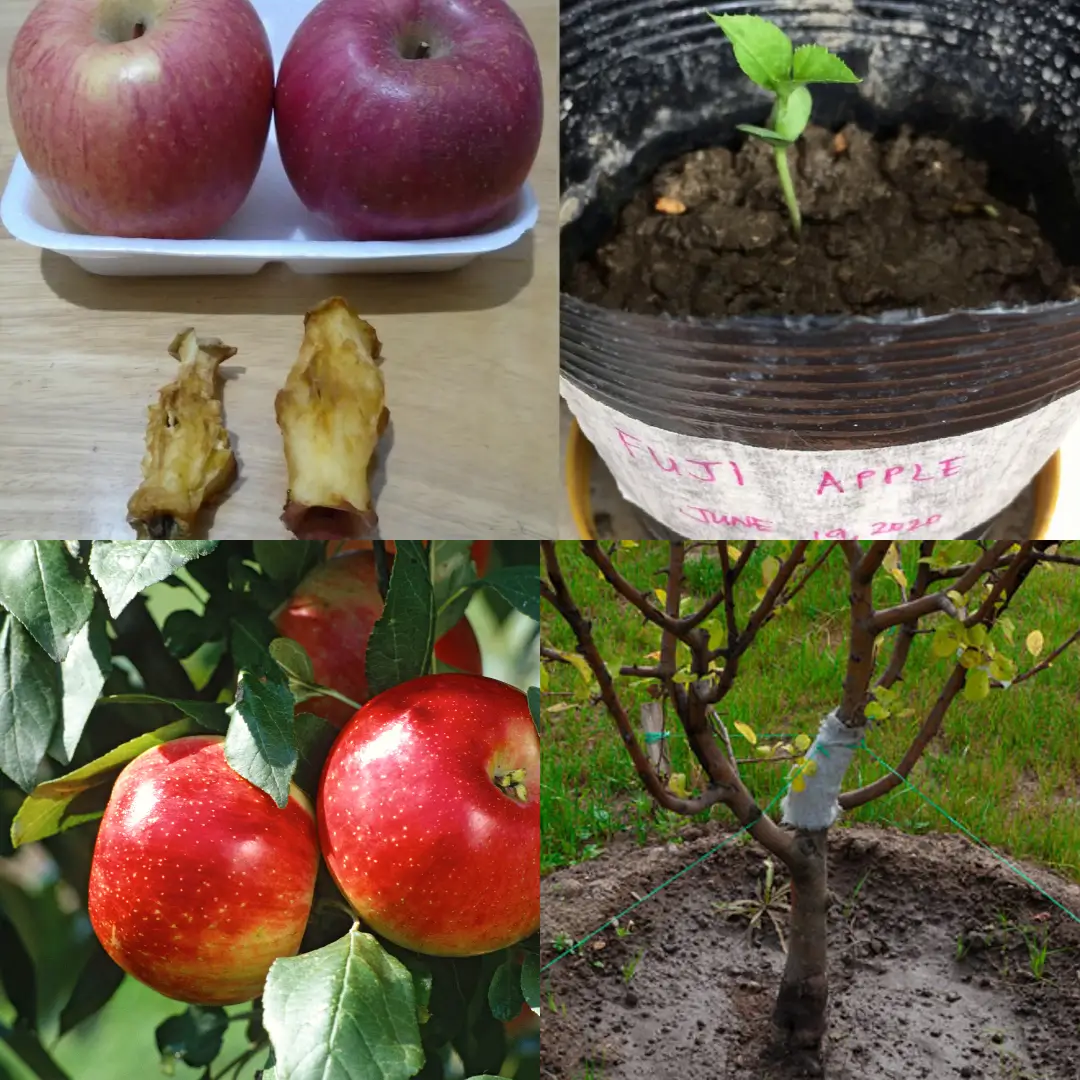Planting an apple tree is more than just a gardening task; it’s a chance to create memories and enjoy homegrown fruit for years to come. Whether you’re a seasoned gardener or new to planting, getting it right from the start makes all the difference. I remember the days when my dad and I planted 60 apple trees in our backyard—those trees are now towering above us, producing the most delicious apples. In this guide, I’ll walk you through the steps on how to plant an apple tree so you can begin your own journey with confidence.
Materials You’ll Need Before You Plant
Before we get into the nitty-gritty of how to plant an apple tree, let’s make sure you’ve got everything ready. Planting an apple tree requires a few key materials to ensure the best start for your tree.
Materials Checklist
- Helper (Planting an apple tree is a two-person job)
- Bucket or bin (To soak the tree’s roots in water)
- Shovel or spade (For digging)
- Stake/post (Needed for dwarf and semi-dwarf apple trees)
- Hammer or rock (To drive the stake into the ground)
- Tree ties (To secure the tree to the stake)
- Tree guards (To protect the tree from animals)
- 1-2 gallons of water
Having all these materials on hand will make the planting process smooth, ensuring you can focus on giving your apple tree the care it needs from the start.
Preparing the Tree for Planting
Now that you have all your materials, the next step is preparing the tree itself. Whether you’re planting bare-root apple trees or ones bought in containers, it’s essential to handle them correctly to avoid damage.
Unpacking and Storing Your Apple Tree
If your tree arrives in a box, which is common if you’ve ordered it online, you’ll need to store it properly until you’re ready to plant. Place the tree in a cool, shaded area—like a garage or basement—and make sure it’s out of direct sunlight.
- If the tree has been in transit for more than four days, soak the roots in water for 6-24 hours before planting.
- If you need to delay planting for more than a week, keep the roots moist by spraying them with water. Keep them wrapped in plastic to maintain moisture.
Proper preparation ensures that your apple tree stays healthy before it’s planted.
How to Prepare the Soil for Your Apple Tree
The soil you plant your apple tree in will play a huge role in its growth. Apple trees love well-draining, nutrient-rich, loamy soil that’s slightly acidic.
Testing and Amending the Soil
The ideal pH range for apple trees is between 5.0 and 7.5. If you’re unsure about your soil’s pH, consider testing it using an inexpensive DIY soil test kit.
Once you’ve tested the soil:
- Amend the soil with compost or organic matter to improve its nutrient content, but avoid adding fertilizer directly where the tree’s roots will touch. Fertilizer can burn the roots, causing more harm than good.
- Till the soil to ensure it’s loose enough for the roots to grow deeply. This will help the tree get the water and nutrients it needs.
Digging the Hole: The Foundation of Tree Growth
The next step in how to plant an apple tree is digging the hole. This step might seem simple, but doing it correctly can make a big difference in how well your tree takes root.
How to Dig the Perfect Hole
- Depth and Width: Dig a hole that’s 18 inches deep and 18 inches wide. This will give your tree’s roots enough room to spread and grow.
- Soil Cone: Before placing the tree in the hole, form a small cone of soil at the bottom. This cone will help the tree’s roots fan out naturally, which is crucial for stability and growth.
Placing the Apple Tree: Getting It Just Right
Now that you’ve prepared the hole, it’s time to place the apple tree in its new home. This step requires some careful attention to ensure the tree grows straight and healthy.
How to Place Your Tree Correctly
- Fan Out the Roots: When you place the tree in the hole, make sure the roots slope down the sides of the soil cone you made. Trim any roots that are too long or twisted to allow for better growth.
- Grafted Trees: If your apple tree is grafted, the graft union (where the rootstock meets the trunk) should be about 2 inches above ground. This ensures the tree maintains the desirable traits of the rootstock.
By setting the tree at the right depth and spreading the roots, you’re giving your apple tree the best chance for success.
Staking Your Apple Tree: Supporting Its Growth
If you’re planting a dwarf or semi-dwarf apple tree, staking is essential to keep the tree upright as it grows.
How to Stake an Apple Tree
- Choose a solid stake that’s 8 to 10 feet tall. Metal stakes work best for long-term support.
- Place the stake next to the tree and drive it into the ground using a hammer or rock. Make sure it’s sturdy enough to bear the weight of the tree.
Staking helps your tree grow straight and strong, preventing it from leaning or falling over as it matures.
Filling the Hole: The Right Way to Pack Soil
With the tree in place and the stake secured, it’s time to fill the hole. This step is crucial because improper soil packing can lead to air pockets, which can harm the roots.
How to Fill the Hole Around Your Tree
- Fill halfway with soil and press it down gently with your foot to remove air pockets.
- Avoid adding fertilizer to the hole as it can damage the roots. Instead, use the nutrient-rich topsoil that you dug out earlier.
If your tree is on a slope, build a 2-foot rim of soil around the base to help retain water.
Watering Your Apple Tree: Hydration Is Key
Watering is essential right after planting, and continuing to water consistently will ensure your apple tree thrives.
How to Water Your Apple Tree Properly
- Immediately after planting, water the tree with 1-2 gallons of water. If the soil settles after watering, add more soil to fill the gap.
- For the first year, water your tree 1-2 times a week, especially during dry spells. After that, you’ll only need to water it when the tree is showing signs of stress, such as drooping leaves.
Proper watering establishes a healthy root system, helping the tree grow faster and stronger.
Pruning Your Apple Tree: Shaping Its Future
Pruning is often overlooked when planting a new apple tree, but it’s a critical step in ensuring the tree grows in the right shape.
How to Prune an Apple Tree After Planting
- Remove lower branches that are less than 2 feet from the ground. This encourages upward growth.
- Cut the central leader (the main vertical branch) to about 18 inches above the highest scaffold branch. This will promote a strong, pyramidal shape.
- Prune the scaffold branches to 12 inches long and ensure they are growing at a 45-60 degree angle for better fruit production.
Pruning may seem intimidating, but it’s essential for the long-term health of your apple tree.
Protecting Your Tree from Wildlife
After all that hard work planting your apple tree, the last thing you want is for animals to damage it. That’s where tree guards come in.
How to Protect Your Tree
- Wrap a tree guard around the trunk to protect against rabbits, mice, and other rodents. Be sure the guard allows for airflow to prevent rot.
- Apply mulch around the base of the tree to retain moisture and keep weeds at bay. Be careful not to let the mulch touch the tree bark, as this can lead to rot.
The Most Important Step: Have Fun!
Planting an apple tree is about more than just following steps—it’s about enjoying the process. Involve family or friends, and make it a fun experience. Mistakes are part of the learning process, and soon enough, you’ll be enjoying the fruits of your labor—literally!
Planting an apple tree is a fulfilling task that, when done correctly, will reward you with delicious fruit for years to come. By following this guide on how to plant an apple tree, you’ll ensure your tree grows healthy and strong. From preparing the soil to pruning and protecting, each step is crucial in giving your apple tree the best start. So grab your shovel, invite some friends or family, and enjoy the process of planting your apple tree. After all, the sweetest apples come from the trees you plant yourself!
FAQs
1. What is the best time to plant an apple tree?
The best time to plant an apple tree is during early spring or late fall when the tree is dormant. This gives the tree enough time to establish its roots before facing extreme weather conditions.
2. How do you start apple seeds?
To start apple seeds, you’ll need to go through a process called stratification. This involves chilling the seeds in a damp paper towel inside the refrigerator for about 6-8 weeks. After that, you can plant the seeds in nutrient-rich soil, keeping them moist and in a sunny spot.
3. Where is it best to plant apple trees?
Apple trees thrive best in full sunlight and in areas with well-draining, slightly acidic soil. They should be planted in a location that receives at least 6-8 hours of direct sunlight each day and has good air circulation to prevent diseases.
4. How long does it take to grow an apple tree from scratch?
Growing an apple tree from a seed can take 6-10 years before it produces fruit. If you plant a young apple tree (from a nursery), it typically takes about 3-5 years for the tree to bear fruit.


